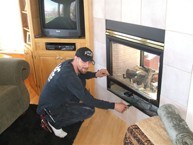There are few things more relaxing than making use of your fireplace on a chilly night. Don’t trick yourself into thinking that because it is not a primary heat source your Plymouth chimney does not need to be inspected and cleaned, though. Any use of your fireplace requires basic maintenance to keep it safe. Here are some common questions that people have regarding chimney sweeping.
How Often Should I Clean My Chimney?
Fire safety experts generally agree that yearly maintenance is necessary for a safe chimney. Remember, even though it is not heavily used your chimney could have poor ventilation from animal nests or suffer from a damaged liner or flu. A yearly inspection and cleaning will keep your chimney safe and functional.
How Long Does A Sweeping Take, and Is There a Mess?
Generally a chimney sweeping should be done in about an hour, though if problems are discovered it can take longer. As for a mess, yes, chimney sweeping is messy business. Thankfully a professional service like ours always has the appropriate equipment to leave your fire area cleaner than when we got there.
Why is Video Inspection Necessary?
A video inspection is, simply put, the most thorough way to ensure that your chimney is in safe working order. If our professional chimney sweepers notice any warning signs or safety hazards, the best way to evaluate the level of concern is with video inspection. The accessible parts of a chimney are only part of a complete inspection.
Can I Install My Wood Stove Insert Directly Into My Fireplace?
Maybe. Some prefabricated wood stoves require a specific chimney that is installed with the insert. Some are adaptable to existing fireplaces, but it is important that a qualified contractor do the installation to ensure that the stove and chimney are compatible as well as to properly insulate and seal the components.
If I’ve Had a Chimney Fire Can I Still Use My Fireplace?
The only way to be sure that your fireplace is safe to use is by having it professionally inspected. If you have a tile or clay liner, for example, you may need to have a new liner installed as these materials are very susceptible to heat. If any insulation or other materials are exposed through a crack it is very possible that another chimney fire may occur.
We at 2nd Generation Chimneys, Inc. hope that this information has cleared up a few questions you may have had. Remember, we’re here whenever you need us, so if you have a question that was not addressed or have any other concerns, call us now. We’re here to help with any issues your Plymouth chimney is experiencing.
Continue Reading
Tags: Chimney FAQ, Chimney Inspection, chimney sweeping, Circle Pines, Minnetonka, Plymouth
Posted in Chimney | Comments Off on Plymouth Chimney Sweeping FAQ’s

